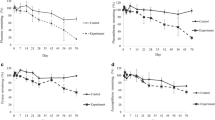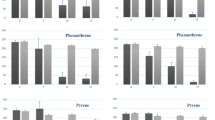Abstract —
The summer of 2015 was characterized by a large number of forest fires along the coastline of Lake Baikal. The concentrations of all analyzed polycyclic aromatic hydrocarbons (PAHs) in the surface microlayer of Lake Baikal during wildfires in August 2015 were significantly increased compared to August 2017, when there were fewer fires. Among the PAHs, naphthalene, phenanthrene and pyrene dominated in the surface microlayer in August 2015, while in August 2017, only naphthalene and its derivatives were prevalent. To evaluate the PAH-degrading capacity of the strains Pseudomonas sp. P30, Microbacterium sp. NC4, Massilia sp. NC8, Flavobacterium sp. NC135, Pseudomonas sp. NC83, and Bacillus sp. P29.2.1 isolated from the Lake Baikal surface microlayer, a laboratory-based experiment was established. Suspension cell cultures in mineral medium were set up in flasks, and naphthalene was added as the only source of carbon. Flasks were incubated for 5–20 days at a temperature of 18°С. It was shown that the strains could effectively biodegrade naphthalene.


Similar content being viewed by others
REFERENCES
Agogué, H., Casamayor, E.O., Joux, F., Obernosterer, I., Dupuy, C., Lantoine, F., Catala, P., Weinbauer, M.G., Reinthaler, T., Herndl, G.J., and Lebaron, P., Comparison of samplers for the biological characterization of the sea surface microlayer, Limnol. Oceanogr. Methods, 2004, vol. 2, pp. 213–225.
Ahn, T.-S., Lee, G.-H., and Song, H.-G., Biodegradation of phenanthrene by psychrotrophic bacteria from Lake Baikal, J. Microbiol. Biotechnol., 2005, vol. 15, pp. 1135–1139.
Alves, C.A., Vicente, A., Monteiro, C., Gonçalves, C., Evtyugina, M., and Pio, C., Emission of trace gases and organic components in smoke particles from a wildfire in a mixed-evergreen forest in Portugal, Sci. Total Environ., 2011, vol. 409, pp. 1466–1475.
Baboshin, M. and Golovleva, L., Characterization of hydrophobic organic contaminant biodegradation by COD analysis, Int. Biodeter. Biodegr., 2011, vol. 65, pp. 883–889.
Baboshin, M.A. and Golovleva, L.A., Aerobic bacterial degradation of polycyclic aromatic hydrocarbons (PAHs) and its kinetic aspects, Microbiology (Moscow), 2012, vol. 81, no. 6, pp. 639–650.
Bastiaens, L., Springael, D., Wattiau, P., Harms, H., de Wachter, R., Verachtert, H., and Diels, L., Isolation of adherent polycyclic aromatic hydrocarbon (PAH)-degrading bacteria using PAH-sorbing carriers, Appl. Environ. Microbiol., 2000, vol. 66, pp. 1834–1843.
Campos, I., Abrantes, N., Vidal, T., Bastos, A.C., Gonçalves, F., and Keizer, J.J., Assessment of the toxicity of ash-loaded runoff from a recently burnt eucalypt plantation, Eur. J. For. Res., 2012, vol. 131, pp. 1889–1903.
Cerniglia, C.E., Biodegradation of polycyclic aromatic hydrocarbons, Biodegradation, 1992, vol. 3, pp. 351–368.
Coelho, F.J.R.C., Sousa, S., Santos, L., Santos, A.L., Almeida, A., Gomes, N.C.M., and Cunha, A., PAH degrading bacteria in an estuarine system, in Interdisciplinary Studies on Environmental Chemistry—Biological Responses to Contaminants, Hamamura, N., Suzuki, S., Mendo, S., Barroso, C.M., Iwata, H., and Tanabe, S., Eds., Tokyo: Terrapub, 2010, pp. 77–87.
Coelho, F.J.R.C., Sousa, S., Santos, L., Santos, A.L., Almeida, A., Gomes, N.C.M., and Cunha, A., Exploring hydrocarbonoclastic bacterial communities in the estuarine surface microlayer, Aquat. Microb. Ecol., 2011, vol. 64, pp. 185–195.
Earl, S.R. and Blinn, D.W., Effects of wildfire ash on water chemistry and biota in South-Western USA streams, Freshw. Biol., 2003, vol. 48, pp. 1015–1030.
Fleming, J.T., Sanseverino, J., and Sayler, G.S., Quantitative relationship between naphthalene catabolic gene frequency and expression in predicting PAH degradation in soils at town gas manufacturing sites, Environ. Sci. Technol., 1993, vol. 27, pp. 1068–1074.
Fraser, M., Barker, J.F., Butler, B., Blaine, F., Joseph, S., and Cooke, C., Natural attenuation of a plume from an emplaced coal tar creosote source over 14 years, J. Contam. Hydrol., 2008, vol. 100, pp. 101–115.
Galachyants, A.D., Tomberg, I.V., Sukhanova, E.V., Shtykova, Yu.R., Suslova, M.Yu., Zimens, E.A., Blinov, V.V., Sakirko, M.V., Domysheva, V.M., and Belykh, O.I., Bacterioneuston in Lake Baikal: abundance, spatial and temporal distribution, Int. J. Environ. Res. Public Health, 2018, vol. 15.
Garrett, W. D., Collection of slick-forming materials from the sea surface, Limnol. Oceanogr., 1965, vol. 10, pp. 602–605.
Gorshkov, A.G., Izosimova, O.N., and Kustova, O.V., Determination of priority polycyclic aromatic hydrocarbons in water at the trace level, J. Anal. Chem., 2019, vol. 74, pp. 771–777.
Gorshkov, A.G., Marinayte, I.I., Zemskaya, T.I., and Khodzher, T.V., Modern level of petroleum products in water of Lake Baikal and its tributaries, Chem. Sustain. Dev., 2010, vol. 18, pp. 623–630.
Hassanshahian, M., Abarian, M., and Cappello, S., Biodegradation of aromatic compounds, in Biodegradation and Bioremediation of Polluted Systems—New Advances and Technologies, Chamy, R., Rosenkranz, F., and Soler, L., Eds., London, United Kingdom: IntechOpen, 2015, pp. 109–123.
Kahng, H.-Y., Cellular responses of Pseudomonas sp. KK1 to two-ring polycyclic aromatic hydrocarbon, naphthalene, J. Korean Soc. Microbiol., 2002, vol. 40, pp. 38–42.
Lundstedt, S., White, P.A., Lemieux, C.L., Lynes, K.D., Lambert, I.B., Öberg, L., Haglund, P., and Tysklind, M., Sources, fate, and toxic hazards of oxygenated polycyclic aromatic hydrocarbons (PAHs) at PAH-contaminated sites, AMBIO, 2007, vol. 36, pp. 475–485.
Mansilha, C., Carvalho, A., Guimarães, P., and Espinha Marques, J., Water quality concerns due to forest fires: polycyclic aromatic hydrocarbons (PAH) contamination of groundwater from mountain areas, J. Toxicol. Environ. Health, Part A, 2014, vol. 77, pp. 806–815.
Olivella, M.A., Ribalta, T.G., de Febrer, A.R., Mollet, J.M., and de las Heras, F.X.C., Distribution of polycyclic aromatic hydrocarbons in riverine waters after Mediterranean forest fires, Sci. Total Environ., 2006, vol. 355, pp. 156–166.
Porter, K.G. and Feig, Y.S., The use of DAPI for identifying and counting aquatic microflora, Limnol. Oceanogr., 1980, vol. 25, pp. 943–948.
Schäfer, R.B., Hearn, L., Kefford, B.J., Mueller, J.F., and Nugegoda, D., Using silicone passive samplers to detect polycyclic aromatic hydrocarbons from wildfires in streams and potential acute effects for invertebrate communities, Water Res., 2010, vol. 44, pp. 4590–4600.
Silva, V., Pereira, J.L., Campos, I., Keizer, J.J., Gonçalves, F., and Abrantes, N., Toxicity assessment of aqueous extracts of ash from forest fires, Catena, 2015, vol. 135, pp. 401–408.
Spencer, C.N. and Hauer, F.R., Phosphorus and nitrogen dynamics in streams during a wildfire, J. North Am. Benthol. Soc., 1991, vol. 10, pp. 24–30.
Vicente, A., Alves, C., Monteiro, C., Nunes, T., Mirante, F., Evtyugina, M., Cerqueira, M., and Pio, C., Measurement of trace gases and organic compounds in the smoke plume from a wildfire in Penedono (central Portugal), Atmos. Environ., 2011, vol. 45, pp. 5172–5182.
Vila-Escalé, M., Vegas-Vilarrúbia, T., and Prat, N., Release of polycyclic aromatic compounds into a Mediterranean creek (Catalonia, NE Spain) after a forest fire, Water Res., 2007, vol. 41, pp. 2171–2179.
Walczak, M., Donderski, W., Mudryk, Z., and Skorczewski, P., Aromatic hydrocarbons decomposition by neustonic bacteria Part II—polycyclic aromatic hydrocarbons biodegradation, Polish J. Environ. Stud., 2001, vol. 10, pp. 33–36.
Wurl, O. and Obbard, J.P., A review of pollutants in the sea-surface microlayer (SML): a unique habitat for marine organisms, Mar. Pollut. Bull., 2004, vol. 48, pp. 1016–1030.
Funding
This research was funded by the national government and was carried out within the framework of State Tasks no. 0345-2019-0003 (АААА-А16-116122110061-6) “Microbial and Viral Communities in Biofilms of Freshwater Ecosystems…”, as well as no. 0345-2019-0008 (AAAA-A16-116122110065-4) “Assessment and Prognosis of the Ecological State of Lake Baikal…”, and the RFBR project no. 18-34-00309 (АААА-А18-118032190039-1).
Author information
Authors and Affiliations
Corresponding author
Ethics declarations
DISCLOSURE OF POTENTIAL CONFLICTS OF INTERESTS
The authors declare that they have no conflict of interes-t.
INFORMED CONSENT
Informed consent was obtained from all individual participants included in the study.
Rights and permissions
About this article
Cite this article
Galachyants, A.D., Suslova, M.Y., Marinayte, I.I. et al. Polycyclic Aromatic Hydrocarbons in the Surface Microlayer of Lake Baikal during Wildfires and Naphthalene-degrading Strains from the Bacterioneuston. Microbiology 89, 609–615 (2020). https://doi.org/10.1134/S0026261720050082
Received:
Revised:
Accepted:
Published:
Issue Date:
DOI: https://doi.org/10.1134/S0026261720050082




